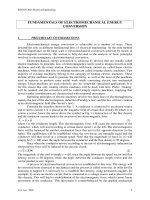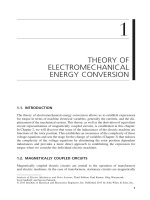Lecture Electromechanical energy conversion: Polyphase Induction Machines - Nguyễn Công Phương
Bạn đang xem bản rút gọn của tài liệu. Xem và tải ngay bản đầy đủ của tài liệu tại đây (598.35 KB, 39 trang )
Nguyễn Công Phương
ELECTROMECHANICAL ENERGY
CONVERSION
Polyphase Induction Machines
Contents
I. Magnetic Circuits and Magnetic Materials
II. Electromechanical Energy Conversion
Principles
III. Introduction to Rotating Machines
IV. Synchronous Machines
V. Polyphase Induction Machines
VI. DC Machines
VII.Variable – Reluctance Machines and Stepping
Motors
VIII.Single and Two – Phase Motors
IX. Speed and Torque Control
sites.google.com/site/ncpdhbkhn
2
Polyphase Induction Machines
1. Introduction to Polyphase Induction Machines
2. Currents and Fluxes in Polyphase Induction
Machines
3. Induction – Motor Equivalent Circuit
4. Analysis of the Equivalent Circuit
5. Torque and Power by Use of Thevenin’s
Theorem
6. Parameter Determination from No – Load and
Blocked – Rotor Tests
7. Effects of Rotor Resistance
sites.google.com/site/ncpdhbkhn
3
Introduction to Polyphase
Induction Machines (1)
• Induction motor: alternating current is supplied to the stator
directly & to the rotor by induction or transformer action
from the stator.
• Two kinds of rotor:
– Wound rotor (relatively uncommon)
– Squirrel-cage rotor (the most commonly used)
sites.google.com/site/ncpdhbkhn
4
Introduction to Polyphase
Induction Machines (2)
• The rotor speed: n (r/min).
• The synchronous speed of the stator field: ns
(r/min).
• The rotor slip: ns – n (r/min)
ns n
(%)
• The fractional slip: s
ns
• the rotor speed: n = (1 – s)ns
• The mechanical angular velocity: ωm = (1 – s)ωs
• The slip frequency: fr = sfe
sites.google.com/site/ncpdhbkhn
5
Introduction to Polyphase
Induction Machines (3)
• The rotor terminals of an induction motor are
short circuited.
• The rotating air – gap flux induces slip –
frequency voltages in the rotor windings.
• The operating speed can never equal the
synchronous speed.
• The rotor currents produce a rotating flux wave
which rotate at sns (r/min) with respect to the
rotor.
• The rotor speed: n (r/min)
• The speed of the rotor’s flux wave:
sns + n = sns + ns(1 – s) = ns
sites.google.com/site/ncpdhbkhn
6
Introduction to Polyphase
Induction Machines (4)
• The speed of the stator field: ns (r/min).
• The speed of the rotor field: ns (r/min).
• the rotor currents produce a field which
rotates at synchronous speed and hence in
synchronism with that produced by the stator
currents.
• the stator & rotor fields are stationary with
respect to each other, & produce a steady
torque, called asynchronous torque.
sites.google.com/site/ncpdhbkhn
7
Introduction to Polyphase
Induction Machines (5)
sites.google.com/site/ncpdhbkhn
8
Polyphase Induction Machines
1. Introduction to Polyphase Induction Machines
2. Currents and Fluxes in Polyphase Induction
Machines
3. Induction – Motor Equivalent Circuit
4. Analysis of the Equivalent Circuit
5. Torque and Power by Use of Thevenin’s
Theorem
6. Parameter Determination from No – Load and
Blocked – Rotor Tests
7. Effects of Rotor Resistance
sites.google.com/site/ncpdhbkhn
9
Currents and Fluxes in Polyphase
Induction Machines (1)
Resultant flux – density
wave
Rotor – mmf
wave
a c
b a
90o
c b
Rotation
Resultant flux – density
wave
Rotor – mmf
wave
a c
a
b a
90o
c b
a
Rotation
sites.google.com/site/ncpdhbkhn
10
Currents and Fluxes in Polyphase
Induction Machines (2)
Flux-density wave
Instantaneous bar – voltage
magnitudes
s
1 2 3 4 5 6 7 8 9
11 12 13 14 15 16 1
(1 s )s
s
Instantaneous bar – current
magnitudes
1 2 3 4 5 6 7 8 9
11 12 13 14 15 16 1
sites.google.com/site/ncpdhbkhn
(1 s )s
11
Currents and Fluxes in Polyphase
Induction Machines (3)
Rotor – mmf wave
Flux-density wave
s
1 2 3 4 5 6 7 8
9
11 12 13 14 15 16 1
(1 s )s
Fundamental component of
rotor – mmf wave
sites.google.com/site/ncpdhbkhn
12
Polyphase Induction Machines
1. Introduction to Polyphase Induction Machines
2. Currents and Fluxes in Polyphase Induction
Machines
3. Induction – Motor Equivalent Circuit
4. Analysis of the Equivalent Circuit
5. Torque and Power by Use of Thevenin’s
Theorem
6. Parameter Determination from No – Load and
Blocked – Rotor Tests
7. Effects of Rotor Resistance
sites.google.com/site/ncpdhbkhn
13
Induction – Motor Equivalent
Circuit
a
R1
Vˆ1
Iˆ1
X1
Iˆc
Rc
Iˆ
Iˆ2
Iˆm
Eˆ 2
X2
R2
s
Xm
b
sites.google.com/site/ncpdhbkhn
14
Polyphase Induction Machines
1. Introduction to Polyphase Induction Machines
2. Currents and Fluxes in Polyphase Induction
Machines
3. Induction – Motor Equivalent Circuit
4. Analysis of the Equivalent Circuit
5. Torque and Power by Use of Thevenin’s
Theorem
6. Parameter Determination from No – Load and
Blocked – Rotor Tests
7. Effects of Rotor Resistance
sites.google.com/site/ncpdhbkhn
15
Analysis
of the Equivalent Circuit (1)
a
Pgap
R
n I 2
s
2
ph 2
R1
Iˆ1
Protor n I R2
Pmech Pgap Protor
Rc
1 s
s
Pmech (1 s ) Pgap
Protor sPgap
Iˆm
X2
R2
s
Eˆ 2
Xm
a
R1
Vˆ1
Iˆ2
b
2 R2
n ph I 2
n ph I 22 R2
s
n ph I 22 R2
Iˆ
Iˆc
Vˆ1
2
ph 2
X1
Iˆ1
X1
Iˆc
Rc
Iˆ
Iˆ2
Iˆm
R2
Eˆ 2
Xm
b
sites.google.com/site/ncpdhbkhn
X2
1 s
R2
s
16
Ex. 1
Analysis
of the Equivalent Circuit (2)
A three – phase, two – pole, 60-Hz induction motor is operating at 3502 r/min with
an input power of 15.7 kW and a terminal current of 22.6 A, the stator – winding
resistance is 0.20 Ω/phase. Calculate the power dissipated in rotor?
Pstator 3I12 R1 3 22.62 0.2 306 W
Pgap Pinput Pstator 15.7 0.3 15.4 kW
ns
120
120
fe
60 3600 r/min
poles
2
ns n 3600 3502
s
0.0272
ns
3600
Protor sPgap 0.0272 15.4 419 W
sites.google.com/site/ncpdhbkhn
17
Analysis
of the Equivalent Circuit (3)
Pmech mTmech
m (1 s )s
Pmech (1 s )sTmech
Pmech (1 s ) Pgap
Tmech
Pgap
Pgap
s
R2
n I
s
2
ph 2
Tmech
Pshaft
n ph I 22 ( R2 / s )
s
Pmech Prot
Tshaft Tmech Trot
sites.google.com/site/ncpdhbkhn
18
Ex. 2
Analysis
of the Equivalent Circuit (4)
Given a three – phase, six – pole, Y – connected, 220-V (line-to-line) 60-Hz 7.5-kW
induction motor, R1 = 0.249Ω/phase, R2 = 0.144, X1 = 0.503, X2 = 0.209, Xm = 13.25,
Prot = 403W (independent of load), s = 2%. Compute the speed, output torque and
power, stator current, power factor, and efficiency?
a
R2
jX
2 jX m
s
Z ab
R2
jX 2 jX m
s
R1
Iˆ1
Vˆ1
0.144
j
0.209
j13.25
0.02
0.144
j 0.209 j13.25
0.02
X1
Iˆ2
Iˆm
X2
Eˆ 2
R2
s
Xm
b
5.43 j 3.11
220
Vˆ1
3
ˆI
15.93 j10.14 18.88 32.5o A
1
R1 jX 1 Z ab 0.249 j 0.503 5.43 j 3.11
sites.google.com/site/ncpdhbkhn
19
Ex. 2
Analysis
of the Equivalent Circuit (5)
Given a three – phase, six – pole, Y – connected, 220-V (line-to-line) 60-Hz 7.5-kW
induction motor, R1 = 0.249Ω/phase, R2 = 0.144, X1 = 0.503, X2 = 0.209, Xm = 13.25,
Prot = 403W (independent of load), s = 2%. Compute the speed, output torque and
power, stator current, power factor, and efficiency?
Iˆ1 15.93 j10.14 18.88 32.5o A
pf cos( 32.5o ) 0.844 lagging
ns
120
120
fe
60 1200 r/min
poles
6
n (1 s )ns (1 0.02)1200 1176 r/min
s
2
2
2
e
2 f e 2 60 125.7 rad/sec
poles
poles
6
m (1 s )s (1 0.02)125.7 123.2 rad/sec
sites.google.com/site/ncpdhbkhn
20
Analysis
of the Equivalent Circuit (6)
Ex. 2
Given a three – phase, six – pole, Y – connected, 220-V (line-to-line) 60-Hz 7.5-kW
induction motor, R1 = 0.249Ω/phase, R2 = 0.144, X1 = 0.503, X2 = 0.209, Xm = 13.25,
Prot = 403W (independent of load), s = 2%. Compute the speed, output torque and
power, stator current, power factor, and efficiency?
a
Iˆ 18.88 32.5o A
1
Z ab 5.43 j 3.11
R1
Pgap 3I12 Rab
Iˆ1
X1
Vˆ1
3 18.82 5.41 5740W
Pshaft Pmech Prot
Iˆ2
Iˆm
X2
Eˆ 2
R2
s
Xm
b
(1 s ) Pgap Prot (1 0.02)5740 403 5220W
Tshaft
Pshaft
m
5220
42.4Nm
123.2
sites.google.com/site/ncpdhbkhn
21
Analysis
of the Equivalent Circuit (7)
Ex. 2
Given a three – phase, six – pole, Y – connected, 220-V (line-to-line) 60-Hz 7.5-kW
induction motor, R1 = 0.249Ω/phase, R2 = 0.144, X1 = 0.503, X2 = 0.209, Xm = 13.25,
Prot = 403W (independent of load), s = 2%. Compute the speed, output torque and
power, stator current, power factor, and efficiency?
Pshaft 5220W
Pin 3Re{Vˆ1 Iˆ1*}
3Re{127(18.88 32.5o )}
6060W
Pshaft
Pin
5220
86.1%
6060
sites.google.com/site/ncpdhbkhn
22
Polyphase Induction Machines
1. Introduction to Polyphase Induction Machines
2. Currents and Fluxes in Polyphase Induction
Machines
3. Induction – Motor Equivalent Circuit
4. Analysis of the Equivalent Circuit
5. Torque and Power by Use of Thevenin’s
Theorem
6. Parameter Determination from No – Load and
Blocked – Rotor Tests
7. Effects of Rotor Resistance
sites.google.com/site/ncpdhbkhn
23
Torque and Power by Use of
Thevenin’s Theorem (1)
Vˆ1,eq Vˆ1
Z1,eq
jX m
R1 j ( X 1 X m )
jX m ( R1 jX 1 )
R1 j ( X 1 X m )
a
R1
Iˆ1
X1
Iˆ2
Iˆm
Vˆ1
Eˆ 2
Iˆ2
Tmech
Z1,eq jX 2 R2 / s
2
ph 2
n I ( R2 / s )
s
R2
s
Xm
R1,eq jX 1,eq
Vˆ1,eq
X2
b
a
R1,eq
Vˆ1,eq
X 1,eq
Iˆ2
Eˆ 2
sites.google.com/site/ncpdhbkhn
R2
s
n phV1,2eq ( R2 / s )
1
s ( R1,eq R2 / s ) 2 ( X 1,eq X 2 ) 2
X2
b
24
Torque and Power by Use of
Thevenin’s Theorem (2)
Tmech
n phV1,2eq ( R2 / s )
1
,
s ( R1,eq R2 / s ) 2 ( X 1,eq X 2 ) 2
s
ns n
ns
Motor
600
400
200
0
Braking region
Motor region
Generator region
Torque
-200
Generator
-400
-600
-800
-1000
-1200
2
1.5
1
0.5
0
-0.5
-1
-1.5
Fractional slip s
sites.google.com/site/ncpdhbkhn
25









